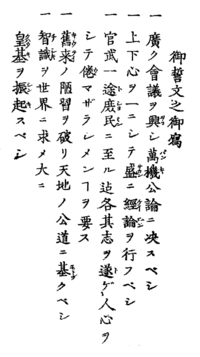
The Charter Oath was promulgated at the enthronement of Emperor Meiji of Japan on April 7, 1868. The Oath outlined the main aims and the course of action to be followed during Emperor Meiji's reign, setting the legal stage for Japan's modernization. It remained influential, if less for governing than inspiring, throughout the Meiji period and into the twentieth century, and can be considered the first constitution of modern Japan. The first draft of the Oath was written by junior councilor Yuri Kimimasa in January 1868, containing progressive language that spoke to the frustrations that the radical but modestly born Meiji leaders had experienced in "service to hereditary incompetents." Yuri's language was moderated by his colleague Fukuoka Takachika in February to be "less alarming," and Kido Takayoshi prepared the final form of the Oath, employing "language broad enough to embrace both readings." The Oath was read aloud by Sanjo Sanetomi in the main ceremonial hall of the Kyoto Imperial Palace in the presence of the Emperor and more than 400 officials. After the reading, the nobles and daimyō present signed their names to a document praising the Oath, and swearing to do their utmost to uphold and implement it. Those not able to attend the formal reading afterward visited the palace to sign their names, bringing the total number of signatures to 767. (Full article...)